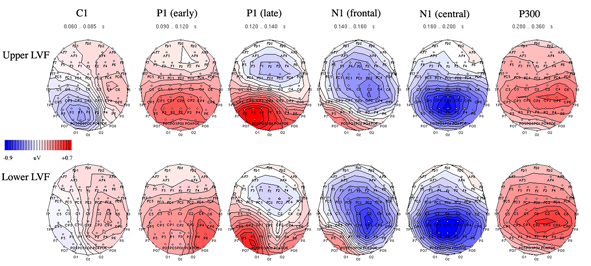Eye gaze direction and spatial attention
General Description
Perceiving the direction of eye gaze of others is fundamental for our social interactions. In our studies, we have investigated how our attention is automatically driven towards targets by the direction of eye gaze of a face. Eye gaze direction is such a powerful cue that it can drive attention even when it is not predictive of the spatial location of a target, and facilitate the processing of the target.

Our experiments have used ERPs to track the time course these effects. Our results indicate that early visual processes (P1 and N1 posterior visual components) in reponse to lateralized targets are both enhanced and speeded up when attention towards the target has been driven automatically by an eye gaze direction. The latency and amplitude effects hold whether the eyes are moving towards a certain location, or remain static (Schuller & Rossion, 2001; 2004).
We have also shown that these effects can be observed for oblique eye gaze directions and target stimuli located in the upper or lower visual fields. However, earlier visual processes indexed by the C1 component (50-80 ms) remain unaffected by attention driven automatically by eye gaze (Schuller & Rossion, 2005).

Related Papers/Abstracts
Schuller, A. M. & Rossion, B. (2005). Spatial attention triggered by eye gaze enhances and speeds up visual processing in upper and lower visual fields beyond early striate visual processing. Clinical Neurophysiology, 116, 2565-2576. [PDF]
Schuller, A.-M. & Rossion, B. (2004). Perception of static eye gaze direction facilitates subsequent early visual processing. Clinical Neurophysiology, 115, 1161-1168. [PDF]
Schuller, A. M. & Rossion, B. (2001). Spatial attention triggered by eye gaze increases and speeds up early visual activity. Neuroreport, 12, 2381-2386. [PDF]


